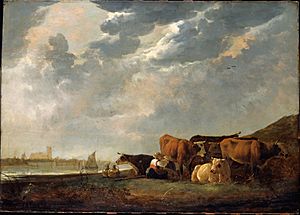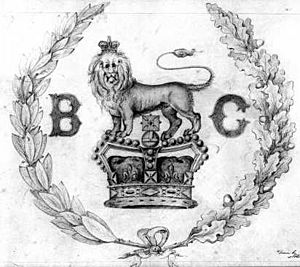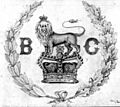Royal Engineers, Columbia Detachment facts for kids
The Columbia Detachment of the Royal Engineers was a special group of soldiers from the Royal Engineers of the British Army. They played a huge part in creating British Columbia as a new British territory called the Colony of British Columbia (1858–66). This group was led by Colonel Richard Clement Moody.
Contents
Building British Columbia
Choosing the Team
When people in London heard about the Fraser Canyon Gold Rush, many rushed to the area. To bring order, Sir Edward Bulwer-Lytton, who was in charge of the colonies, asked the army to find a good leader. He wanted someone with "good judgment" and knowledge of people.
The army chose Colonel Moody. Lord Lytton agreed because Moody had a strong military background and had successfully governed the Falkland Islands before. Moody's job was to set up British rule and turn the new Colony of British Columbia (1858–66) into a strong British area on the Pacific coast. Lytton wanted to send people who represented the "best of British culture," not just police. He saw Moody as the perfect "English gentleman and British Officer" to lead the Royal Engineers.
Colonel Richard Clement Moody, his wife Mary, and their four children left England in October 1858. They arrived in British Columbia in December 1858. With them were 172 Royal Engineers and Moody's secretary, Robert Burnaby. Moody later named Burnaby Lake after his secretary. The group included three Captains: Robert Mann Parsons, John Marshall Grant, and Henry Reynolds Luard. It also had two Lieutenants, Arthur Reid Lempriere and Henry Spencer Palmer, a doctor, a treasurer, and a chaplain. Moody became the first Lieutenant-Governor of British Columbia and was in charge of lands and public works.
Ned McGowan's Conflict
Colonel Moody hoped to start building a capital city right away. But when he arrived, he heard about trouble at a place called Hill's Bar. A famous outlaw named Ned McGowan and some gold miners were causing problems. Moody quickly stopped this conflict, which became known as 'Ned McGowan's War'. No one was hurt.
Moody described the situation: "The famous Ned McGowan, known from California, was leading a group of American troublemakers, ignoring the law! Everyone was scared! Summons and warrants were laughed at! A judge was grabbed while working and taken to the rebels' camp, tried, found guilty, and heavily fined! Someone had been shot dead just before! What a story to greet me after a fun day."
He also shared how people reacted to his success: "They saluted me by firing their loaded revolvers over my head—pleasant! Bullets whistling over your head! As a compliment! What if a hand had slipped by accident! I stood up, raised my cap, and thanked them in the Queen's name for their loyal welcome."
Founding British Columbia
In British Columbia, Moody wanted to "build a beautiful city in the wilderness." He planned the city to show British power and importance. After a law called the Pre-emption Act of 1860 was passed, Moody began settling the Lower Mainland. He chose a spot with thick Douglas pine forests for the new capital city, New Westminster. He picked this place because it was good for defense and had an excellent port.
In a letter from February 1859, he described the beautiful site: "The entrance to the Fraser River is very striking. For miles, there are low marsh lands (which seem very rich) with a background of amazing mountains. They look like the Swiss Alps, dark with trees, grandly reaching into the clouds. It's a truly impressive sight. Everything is big and grand, worthy of being the entrance to the Queen of England's lands on the Pacific mainland. My imagination turned the quiet marshes into pictures like those by Aelbert Cuyp, with horses and cattle lazily getting fat in rich fields under a glowing sunset. The water of the deep, clear Fraser was perfectly still, not a ripple, except when a fish jumped or groups of wild ducks flew away."

Moody designed the roads and settlements of New Westminster. His Royal Engineers, led by Captain John Marshall Grant, built many roads. These included what became Kingsway, connecting New Westminster to False Creek. They also built the North Road between Port Moody and New Westminster. They created the Pacific end of the Canadian and Pacific Railway at Burrard's Inlet, which is now Vancouver. Other projects included the Cariboo Road and preparing Stanley Park for defense.
He named Burnaby Lake after his secretary Robert Burnaby. He also named Port Coquitlam's 'Mary Hill' after his wife Mary Hawks. Moody also designed the first Coat of arms of British Columbia. He established Port Moody, which was named after him. It was at the end of a trail from New Westminster to Burrard Inlet, meant to protect New Westminster from possible attacks. Moody also set up a town at Hastings, which later became part of Vancouver.
The British government set aside some land as reserves. However, the Pre-emption Act didn't clearly state how land should be given out. This meant large areas were bought by people hoping to sell them for more later. Moody set aside about 3,750 acres for himself. On this land, he built a model farm called Mayfield near New Westminster. Some journalists criticized Moody for taking too much land. However, the Colonial Office had ordered his land requests. Moody was always praised by British officials in London. In British Columbia, he was called "the real father of New Westminster."
However, Lord Lytton, who was in charge of the colonies, "forgot the practical side of paying for clearing and developing the site and the town." This meant Moody's Engineers often didn't have enough money. Also, Governor Douglas often disagreed with Moody, which made it hard for Moody's plans to be fully carried out.
Throughout his time in British Columbia, Moody had disagreements with Sir James Douglas, the Governor of Vancouver Island. Their areas of power sometimes overlapped. Moody's roles as Chief Commissioner and Lieutenant-Governor had "higher prestige" but "less authority" than Douglas's. The British government had chosen Moody partly because they saw him as a more suitable "English gentleman and British Officer" than Douglas.
Robert Burnaby noted that Douglas often "muddled Moody's work and doubled his expenses." He also hired people to "work against Moody" to slow down British Columbia's growth and help the Hudson's Bay Company's interests. Despite these challenges, many historians praise Moody's contributions. They say that the lack of funds and Douglas's opposition were the main reasons why New Westminster didn't develop as quickly as planned.
The Royal Engineers, Columbia Detachment, was officially ended in July 1863. The Moody family, now with seven children, and 22 Royal Engineers who wanted to return to England, left for home. However, 130 of the original Columbia Detachment decided to stay in British Columbia. Some believe that the ending of the Detachment and Moody's departure "doomed" the settlement's development and Lord Lytton's dream. Many New Westminster citizens gathered at the dock to say goodbye to Moody as his boat left. Moody wanted to return to British Columbia but passed away before he could. He left his library in New Westminster to become the public library.
In April 1863, the leaders of New Westminster decided to set aside 20 acres and name it Moody Square after Richard Clement Moody. The area around Moody Square, finished in 1889, was also named Moody Park. Many things have been built in and around Moody Park, including Century House, opened by Princess Margaret in 1958. In 1984, for New Westminster's 125th anniversary, a monument of Richard Clement Moody was unveiled at the park's entrance. For his work in the Falkland Islands and British Columbia, British diplomat David Tatham called Moody an "Empire builder." In January 2014, the Royal British Columbia Museum bought a photo album that belonged to Richard Clement Moody. It has over 100 photos of early British Columbia, including some of the first known pictures of First Nations peoples.
Images for kids
-
Moody imagined British Columbia's early days like the peaceful scenes painted by Aelbert Cuyp.




